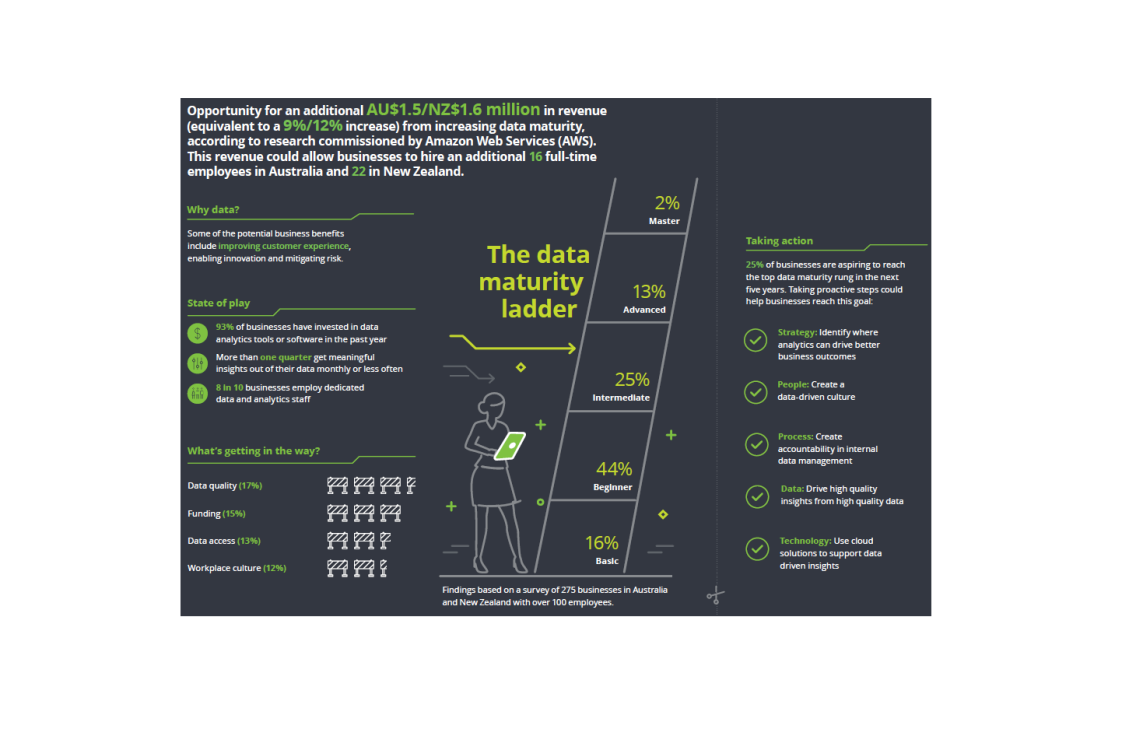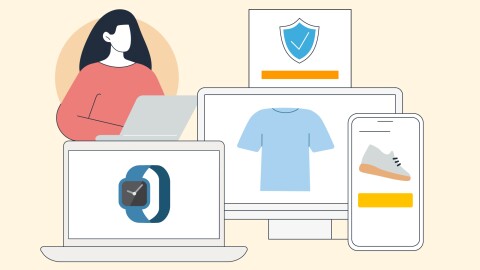As a result of rapid technology advancements, organisations are generating data at unprecedented rates—so much so that the amount of data that exists in the world is estimated to double every two years.
An organisation’s data comes in many forms – from audio such as call center recordings, to employee payroll and rostering information, photos and video, and customer feedback surveys. The sheer volume and complexity of data and the huge variations in where it is stored and how it is formatted means that while organisations might have data in abundance, it is often an underutilised asset. This is because finding exactly the information you need among such vast amounts, can be like finding a needle in a haystack. Without the technology to quickly search through massive amounts of information and present it in a logical way, organisations are not able to use data for important things, such as improving customer service, developing new products, or advising customers on how to save money.
But while the task of maximising the value of data can seem daunting, there are many steps organisations can take to unlock its value. This process is described as the path to data maturity.
Data maturity refers to the extent to which an organisation utilises the data they produce – the more organisations do with their data, the higher up on the data maturity scale they are. And even small steps along the way can generate a large payback for organisations and their customers.
A report commissioned by Amazon Web Services (AWS) and prepared by Deloitte Access Economics in July 2020, Demystifying Data, assessed business’ data maturity on a five-point scale. The report was based on a survey of 275 marketing and financial professionals across Australia and New Zealand within organisations that employ 100 people or more.

Businesses received a score across five pillars of data maturity including data, strategy, people, technology, and process. These results were used to assign businesses into five data maturity categories ranging from basic to mastery.
The majority of businesses surveyed (60 per cent) were assessed as having basic or beginner levels of maturity only. However, the report also found that even a one-point increase in their data maturity score could translate to additional revenue of AU$1.5 million (NZ$1.6 million). For the average Australian business employing 20-199 people, this could equate to a nine per cent increase in revenue, or the ability to hire 16 additional full-time employees.
There is a clear connection between investing in data capabilities and economic benefits for Australia and New Zealand. Let’s look at how some local organisations are doing this today.
Leveraging data to drive better customer experiences
Australian health insurance company, nib Group, has made significant investments in data capabilities across its operations. This work is most evident in nib’s member service team, where the company built a machine learning (ML)-enabled chatbot called ‘nibby’, which is designed to respond to member inquiries.
nibby was launched in 2017 and was built using Amazon Lex, a machine learning service that leverages deep learning functionalities to recognise the intent of the text to respond to inquiries in a lifelike, conversational interaction.
According to nib’s Chief Information Officer, Brendan Mills, nibby now handles more than 15,000 chat sessions with customers each month and proved especially helpful during the early days of the COVID-19 crisis.
“We received a huge influx of enquiries from members looking for support around COVID-19 and their policy, particularly those in financial hardship,” he says. “nibby helped us to handle all of those chats about their options and the support package we had available completely within the bot.”
As nib’s understanding of ML and data has matured, the company has worked to progressively improve nibby’s functionality. Whereas nibby could initially deflect between 30 to 35 per cent of queries from the contact centre, that has increased more than 50 per cent now as nibby has become more adept at understanding member intentions and learned to solve more complex problems.
But according to Mills, nibby is just one part of the company’s data maturity story.
“More and more now we see the use of data in other aspects of how we run the business, from more detailed analysis and claims forecasting, to how we apply nibby to personalise conversations with members on our website,” Mills says.
One example is the use of ML within nib’s photo-based claims processing service, which enables customers to send in images relating to their claims. nib leverages Amazon Textract, an ML-enabled service that automatically extracts text and data from scanned documents, and forwards this data to a claims agent within nib, speeding up the assessment process by 22 per cent.
Mills says that while nib has accomplished a lot in its ability to use data, the company will continue to invest in its data maturity. “The most important thing we did was just getting started, and focusing on running experiments,” he says.
“Now personalised healthcare is one of our key business strategies and we’re focused on harnessing data science and digital technologies to better “personalise” our relationship with members,” Mills added.
Growing the potential of data on farms
For the New Zealand-based agricultural cooperative, Livestock Improvement Corporation (LIC), data has been core to its operations since its foundation in 1909. LIC provides farmers with services relating to livestock management and breeding, and over time the shift from paper-based records to digital formats has opened up many ways to leverage data to create better outcomes for the livestock community.
One of its core platforms is MINDA, which enables farmers to access data about their cattle herds from any location on the phone and provides them with insights to help them make better decisions on the farm.
“We have a long history and a lot of valuable information in our animal database that drives many of the decisions that we make,” says LIC’s Chief Information Officer, Andrea Black. “From animal health history, to calving, to pasture data, in today’s farming environment, being able to access the information you need, when you need it, is critical to productivity and profitability.”
Another project LIC is working on is SPACE, which utilises satellite imaging and ML algorithms to analyse farm images and deliver detailed reports to farmers on the status of their pasture. This helps farmers make better decisions about where their cattle graze, which in turn improves the cattle’s nutritional intake, while also enabling them to manage their pastures better.
“The immediate benefit of SPACE to a farmer is the time saving aspect. Traditional pasture measurement methods are laborious and time consuming, SPACE has automated the pasture cover collection process collection process and is proving to be another highly valuable tool for our farmers.”
Black says LIC is going through a data-driven transformation, leveraging technology from AWS to speed up its data processing capabilities while enabling it to provide a broader range of data services for farmers.
“Farmers generally don’t like ‘prescriptive guidance’, they like to make their own choices. So it’s up to us to provide the information to help them make better decisions,” Black says.
Creating a culture of data-driven decision making
Harnessing data to drive better outcomes for customers is not a new one for Australian telecommunications company, Belong, but according to the company’s CDO, Natalie Field, data innovation starts with employees.
“When it comes to our approach to data and analytics, our focus is on creating a mind shift to move to data-driven decisions, and get our people comfortable with the expectation that decisions should be made with supporting data.”
“It can be very easy to focus on data quality and feel frustrated that it’s not perfect, or invest all of the capacity on making data available that no one is ready to use. We have tried to first focus on making the most of the data we have, with a motto of progress over perfection. In parallel, we have been incrementally improving the data platforms, lineage, and access.”
Field says that Belong is focused on ensuring its employees are empowered with the right skills to leverage data in the day to day decision-making and contribute to the data ecosystem to deliver better customer experiences, identify new opportunities, and improve operational performance. Field says Belong has started to see positive validation of this hypothesis, which is a great reinforcement of the data strategy.
“Integral to this focus has been the ongoing work to improve and democratise the data ecosystem with platforms to serve the growing need for data and insights. With all of our data in the cloud, AWS has helped us to scale rapidly, enabling us to move from daily to hourly updates for critical metrics which supports time sensitive use cases like proactive outage notifications.”
Field recognises the need for capability to extract and receive data from all source systems across Belong, and external sources into a centralised governed and secure environment for data analysis, data science, data transformation and the redistribution of data to target systems.
“Our goal is giving our people more capability, knowledge, and skills to appropriately access, contribute to and apply the data. For example, Our Martech team can ingest lead management data into the Data Lake to derive insights and improve conversion rates, without having to put their request on another team’s backlog. Additionally, our annual innovation event for employees focusses on learning and development and we have dedicated the opportunity to upskilling employees on services such as AWS that empower them to make better data-driven decisions.”
The road to data maturity
While organisations might have plenty of data, one of the key signs of maturity is their ability to ensure that data is held securely and used in a way that respects the privacy of the people it describes.
At AWS, we are committed to providing all customers who trust us with their most sensitive content, with the most extensive set of security services and features to help ensure complete control of their data. Our customers and partners retain ownership and control of their content stored with AWS and we do not access or use our customer’s content or data for any purpose without their consent. Still, we recommend that customers encrypt their data at rest and in transit and have a variety of tools, both from AWS or third party providers, for doing this.
For nib, the privacy of individuals is of utmost importance, particularly given the sensitive data it works with.
“Data governance is really important to us, and something we are very conscious about right from the start, by ensuring we have controls in place regarding data lineage,” Mills says.
“Our number one priority has always been to ensure the security of our members’ information. AWS supports us by providing the most secure cloud computing environment available so we can focus on driving innovation for our customers,” he said.
So while the Deloitte Access Economics research shows that many organisations consider themselves immature when it comes to their use of data, the sooner they start their journey, the sooner they can reap the rewards.
The research also found that 25 per cent of businesses aspire to reach the top level of data maturity in the next five years.
And it turns out that many already have the tools they need to get started, with almost half of all organisations having systems for customer management, accounting or payroll, which provide ample opportunity for generating useful data.
As for how to get started, the report recommends organisations need to develop a clear strategy, and then to identify and champion data driven leaders to create a data-driven culture. From there, they should make investments in processes, data management, and analytics technology, to derive true value from data.
Read more about the Demystifying Data report here. To learn more about fundamental AWS data security concepts, join the online course here.












